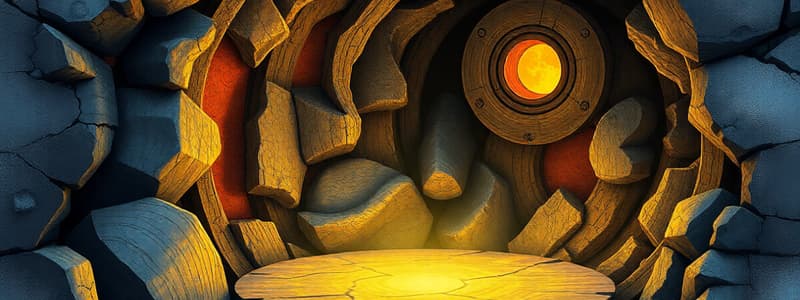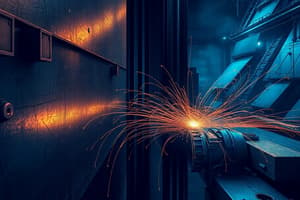Podcast
Questions and Answers
Which of the following metals CAN be machined using the Eroding method?
Which of the following metals CAN be machined using the Eroding method?
- Aluminum (correct)
- Steel (correct)
- Brass (correct)
- Wood
What is the primary factor influencing the machinability of steel?
What is the primary factor influencing the machinability of steel?
- The type of machining process used
- The presence of manganese sulfide
- The amount of lead added
- The structure of the steel (correct)
In the context of steel machinability, what is the primary benefit of adding lead?
In the context of steel machinability, what is the primary benefit of adding lead?
- Increases the strength of steel
- Increases the amount of manganese sulfide formed
- Reduces friction and tool wear (correct)
- Improves the hardenability of steel
Which of these is NOT a type of polishing?
Which of these is NOT a type of polishing?
What is the primary function of manganese sulfide in steel?
What is the primary function of manganese sulfide in steel?
Which of the following elements are commonly found in steel used in moulds?
Which of the following elements are commonly found in steel used in moulds?
What is the typical temperature range generated during the Eroding process?
What is the typical temperature range generated during the Eroding process?
Which of the following factors influences the amount of material removed during the Eroding process?
Which of the following factors influences the amount of material removed during the Eroding process?
Which of the following is NOT considered an advantage of polishing moulds?
Which of the following is NOT considered an advantage of polishing moulds?
What type of material is typically used as a carrier or polishing tool?
What type of material is typically used as a carrier or polishing tool?
What is the primary application of Eroding?
What is the primary application of Eroding?
What is the key difference between Spark Eroding and Wire Cut Eroding?
What is the key difference between Spark Eroding and Wire Cut Eroding?
What does the text suggest about the surface quality of moulds?
What does the text suggest about the surface quality of moulds?
What are the two main types of coatings used for plastic molds?
What are the two main types of coatings used for plastic molds?
Which of the following is NOT a factor influencing the type of polishing used?
Which of the following is NOT a factor influencing the type of polishing used?
What percentage of total mould costs can polishing account for?
What percentage of total mould costs can polishing account for?
What are some common mold components that can be coated to improve performance?
What are some common mold components that can be coated to improve performance?
What is the unit used to measure surface roughness?
What is the unit used to measure surface roughness?
Which of the following is NOT a reason why molds are subjected to abrasive conditions?
Which of the following is NOT a reason why molds are subjected to abrasive conditions?
Which of the following is a common cause of reduced tool lifetime in injection molding?
Which of the following is a common cause of reduced tool lifetime in injection molding?
In the context of PVD, what is the process by which material is converted into a vapor?
In the context of PVD, what is the process by which material is converted into a vapor?
How is material deposited onto the substrate in a PVD process?
How is material deposited onto the substrate in a PVD process?
What is the key difference between PVD and CVD processes?
What is the key difference between PVD and CVD processes?
In a CVD process, what happens to gaseous precursors on the substrate surface?
In a CVD process, what happens to gaseous precursors on the substrate surface?
Flashcards
Quality of Steel
Quality of Steel
Characteristics of steel based on its melt process and inclusions.
Types of Polishing
Types of Polishing
Different polishing techniques include stroke burnish, gloss finish, and mirror finish.
Stroke Burnish
Stroke Burnish
A polishing technique that results in a matte finish.
Gloss Finish
Gloss Finish
Signup and view all the flashcards
Mirror Finish
Mirror Finish
Signup and view all the flashcards
Advantages of Polishing
Advantages of Polishing
Signup and view all the flashcards
Surface Roughness
Surface Roughness
Signup and view all the flashcards
Cost Factor of Polishing
Cost Factor of Polishing
Signup and view all the flashcards
Coatings for Moulds
Coatings for Moulds
Signup and view all the flashcards
Abrasive Wear
Abrasive Wear
Signup and view all the flashcards
Corrosive Wear
Corrosive Wear
Signup and view all the flashcards
Frictional Wear
Frictional Wear
Signup and view all the flashcards
Injection Molding
Injection Molding
Signup and view all the flashcards
Physical Vapor Deposition (PVD)
Physical Vapor Deposition (PVD)
Signup and view all the flashcards
Chemical Vapor Deposition (CVD)
Chemical Vapor Deposition (CVD)
Signup and view all the flashcards
Demoulding Release
Demoulding Release
Signup and view all the flashcards
Machinability of Steel
Machinability of Steel
Signup and view all the flashcards
Lubricating Compounds
Lubricating Compounds
Signup and view all the flashcards
Low Carbon Steel
Low Carbon Steel
Signup and view all the flashcards
Phosphorus in Steel
Phosphorus in Steel
Signup and view all the flashcards
Lead in Low-Alloy Steels
Lead in Low-Alloy Steels
Signup and view all the flashcards
Eroding
Eroding
Signup and view all the flashcards
Wire-Cut Eroding
Wire-Cut Eroding
Signup and view all the flashcards
Spark Eroding
Spark Eroding
Signup and view all the flashcards
Study Notes
Machinability of Steel
- Machinability depends on steel's structure (affected by carbon content) and alloying elements.
- Manganese sulfide compounds (MnS) improve strength, hardenability, and machinability.
- Low carbon and 1.5% manganese content improves chip shape.
- Phosphorus in low concentrations improves chip breaking and surface quality.
- Lead is added to low-alloy steels, creating a lubricating film between the tool and chips. This reduces friction and tool wear, and improves chip breaking.
Eroding
- Material removal using electricity.
- Two types: spark eroding and wire-cut eroding.
- Both methods use an electrode near the workpiece.
- Spark eroding creates a high temperature gap (8000-12000°C), causing material removal via discharges.
- Wire-cut eroding moves a wire electrode close to the workpiece, and electric current creates a spark.
Polishing of Moulds
- Quality of steel affects polishing (processes like melt process and inclusions, and elements like S, Cr, Mo, Ni).
- Specific steel types like 45 NiCrMo4 and 40 CrMnMoS 86 play a role.
- Polishing factors include surface finishing, optical appearance, anti-corrosion, and scratch resistance.
- Types of polishing include stroke burnishing, gloss finishing, and mirror finishing.
- Polishing tools can be steel, brass, copper, felt, or wood.
- Polishing can account for 10-30% of total mould costs.
Coatings for Plastic Moulding
- Moulds face high abrasion and corrosion from fillers, resins, sticking, and fretting.
- Coatings improve mould life, reduce scrap, and improve demoulding processes.
- Two major coating processes include physical vapor deposition (PVD) and chemical vapor deposition (CVD).
Different Coating Processes (PVD and CVD)
- PVD (Physical Vapor Deposition): Vaporization of material by physical processes like sputtering or evaporation.
- Material is ejected from a target and deposited on a substrate.
- PVD process is used to coat a variety of tools and components such as cutting, forming tools, moulds, mechanical components, medical devices, and products that would benefit from hard and decorative coatings.
- PVD process is frequently used for depositing coatings made from nitrides, carbides, and carbonitrides of Ti, Cr, Zr, and Al alloys.
- Material thickness: ~2-5µm
- Process temperatures: ~ 250-450°C
- Substrate materials: steels and non-ferrous metals.
- CVD (Chemical Vapor Deposition): Chemical reactions to create a solid layer.
- Gaseous precursors react to form a solid film on a substrate.
- Precursors can be various materials suitable for coatings (e.g. titanium, tungsten, aluminum).
- Coating thickness: ~ 2-3 µm.
- Coatings can be conductive or non-conductive.
PACVD (Plasma-Assisted Chemical Vapor Deposition)
- Used for coating conductive and non-conductive materials at low temperatures (<200°C).
- Creates amorphous coatings at specific thickness.
- Uniform coating of 3D components without rotation.
CVP (Chemical Vapor Process)
- Process used for creating low stress coatings through thermally-induced reactions.
- Material in vapor form reacts to create a thin film on a substrate.
- Different temperatures and materials for different CVD types (HT & MT).
- Materials are tungsten carbide, tool steel, HT-nickel alloys, and ceramic and graphite.
- Suitable for parts in high-temperature applications
CVA (Chemical Vapor Aluminizing)
- Lowers costs, improves efficiency, and is environmentally friendly.
- Coating process used for high-temperature applications.
- Produces aluminide coatings on various materials such as blades, turbine components etc. This reduces oxidation and corrosion at high temperatures.
Studying That Suits You
Use AI to generate personalized quizzes and flashcards to suit your learning preferences.



